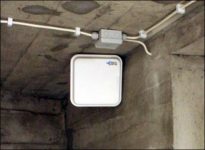
The Nazi Explosive Museum uses RFID technology to ensure the safety of visitors
[ad_1]
The museum located in the explosives factory in Poland during World War II is testing an RFID solution to track the location of visitors. The system also provides visitors with access control to visit abandoned tunnels, production lines and warehouses.
The Exploseum military technology center is composed of 7 explosives factories built by Germany in World War II. The factory was a source of explosives for the German army during World War II, and the workers were mostly Polish prisoners of war. Kinga Dugosz, deputy director of finance and administration at the Exploseum Military Technology Center, said the museum has a factory nitroglycerin production line.

(Smart Technology Group installed 7 UHF RFID reader antennas in the museum building and tunnel to read the UHF RFID inlay ID number in the lanyard)
The museum has workshops and warehouses connected by a network of underground tunnels and was opened to the public in July 2011. Recently, due to safety reasons, the facility only allows visitors to visit the facility when accompanied by a guide. Dugosz said: “Visitors are now only allowed at certain times.”
However, leaving aside the risks, the museum believes that the best way to experience the facility is to walk alone. Therefore, the museum found the Smart Technology Group, a Swiss-Polish joint venture company, and requested the development of a solution using UHF and HF RFID technology to control access rights and monitor visitors.
According to Karolina Kozowska, president of Smart Technology, Exploseum is not a typical museum. Visitors will get lost in such a large area, or encounter a sudden illness but cannot get timely rescue.
Using the RFID solution, visitors will receive a badge with a built-in 13.56MHz passive high frequency and compatible EPC Gen 2 standard passive UHF RFID inlay RFID inlay after purchasing the ticket.
Due to the short reading distance, high-frequency RFID technology can be used to control the authority to open the door, so as to ensure that the authorized person can open the lock within the range. The UHF RFID technology has a longer reading range, which also makes it more suitable for monitoring the location of visitors. The museum also installed closed-circuit television (CCTV) cameras to provide additional security.
At the entrance of the facility, visitors can swipe their lanyard on the ACHF reader installed at the door. The reader can read the ID number embedded in the built-in high-frequency RFID of the lanyard, and then send out a signal to open the door. Buildings and tunnels can only be locked from the outer door, so that in the event of an emergency, visitors can escape without opening the door.

(Each tourist wears a lanyard with built-in HF RFID and UHF RFID embedded)
After the tourists enter the building or tunnel, the lanyard worn by them can be used to track the location of the tourists. Smart Technology installed 7 Master 01 UHF RFID readers and 7 A24 antennas to read the ID number embedded in the UHF RFID lanyard. When visitors walk from one area of the museum to another area, the Master 01 reader will read the ID number and send it to the software running on the PC. Museum managers can log in to the software to view the real-time area location of visitors.
When an emergency occurs, the administrator can also log in to the software to view the information and video information of people still in the building or tunnel. The technology can also detect people stranded in the museum after the end of the day.
If the administrator finds that the visitor cannot find the tunnel exit, the museum can exclude the guide to help the visitor get out of the exit.
Dugosz said: “There are many narrow corridors and tunnels in the museum. This environment can cause visitors to panic or experience claustrophobia. When the management finds that the visitors are behaving strangely (standing motionless), they need to send personnel to check.”
The UHF system covers a total area of 1819 square meters.

(Managers can view the location of tourists on one screen; the live video screen displayed on the other screen)
So far, 100 lanyards have been put in the museum.
Dugosz said: “We are testing the system’s RFID performance. We need at least one tourist season to evaluate whether we need to deploy more RFID solutions.”
[ad_2]



